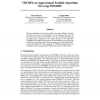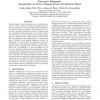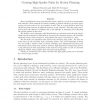350 search results - page 34 / 70 » Complexity of Planning with Partial Observability |
FCS
2007
13 years 10 months ago
2007
In many task-planning domains, dynamic assemblies of autonomous agents are replacing hierarchical organisations because they promise more agility. In such assemblies, interdepende...
NIPS
2004
13 years 10 months ago
2004
Existing algorithms for discrete partially observable Markov decision processes can at best solve problems of a few thousand states due to two important sources of intractability:...
CANDT
2009
14 years 29 days ago
2009
Urban design today faces complex demands. It has become a necessity to negotiate between stakeholder objectives, the expectations of citizens, and the demands of planning. In this...
TSMC
2010
13 years 3 months ago
2010
In model-based control, a planner uses a system description to create a plan that achieves production goals. The same model can be used by model-based diagnosis to indirectly infe...
IJRR
2007
13 years 9 months ago
2007
Many algorithms have been proposed that create a path for a robot in an environment with obstacles. Most methods are aimed at finding a solution. However, for many applications, ...



